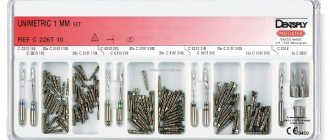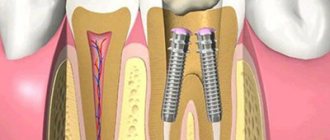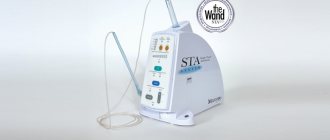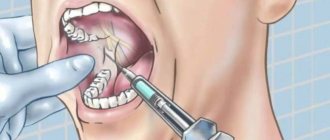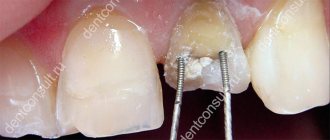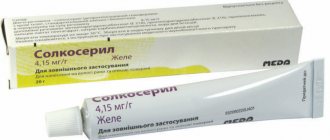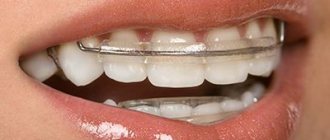In the online store of the LETO trading house you can buy all the necessary tools and materials for simple and high-quality dental restoration. The presented assortment includes several dozen fiberglass pins from trusted manufacturers. They are made in the form of thin rods that have a diameter corresponding to the size of the dental canal. Fiberglass, which forms the basis of the structure, is safe for humans and does not cause allergies. This is largely due to the popularity of these pins in modern dentistry.
Indications and contraindications
Indications for installing fiberglass pins:
- severe damage to the teeth in the lateral and frontal areas;
- restoration by extension onto a rod;
- installation of splinting structures;
- restoration with restoration mixtures;
- in case of destruction of jaw units after serious injuries, fragmentary restoration;
- for prosthetics (it is necessary to create a reliable support when using ceramic prostheses).
Contraindications:
- pathology of hard tissues;
- blood clotting is poor;
- the root part is used for support;
- chronic diseases of the nervous system, mental illness;
- caries;
- granulomas, soft tissue cysts;
- The thickness of the root part is insufficient.
general characteristics
A pin is a supporting device for fixing dental prostheses. The duration of use of the artificial tooth depends on the strength and reliability of the rod.
The product is made from fiberglass. The material is widely used in various fields of medicine. Its popularity is due to its hypoallergenicity, elasticity and ability to reduce stress on soft tissues.
Fiberglass pins are lightweight, durable, flexible, and able to bend and return to their original position.
Transparent color makes the product invisible in the oral cavity.
Advantages and disadvantages
Advantages:
- there are no large volumes of tooth decay;
- the rod is elastic, its properties are as close as possible to the characteristics of dentin;
- uniform distribution of loads and pressure, restoration of dentition functions;
- the rods do not contain nickel, chromium, or other elements that negatively affect health or cause allergic reactions;
- light transmission is excellent;
- the ability to accurately select the shade of enamel;
- Removing the structure if necessary is simple.
Flaws:
- There are risks of chipping due to insufficient experience of the doctor or violation of prosthetic technology.
Difference between fiberglass and titanium pins
The main advantage of fiberglass pins over titanium ones is the absence of any chemical reactions when interacting with saliva and teeth. If the tooth restoration procedure takes place without the use of a crown, then pins of this type are the best option, since, unlike titanium ones, they have a natural color and excellent adhesion of the pin to the filling material. A fiberglass pin is also safer , since its use does not allow the root of the treated tooth to be broken. Our dentists at the Zhemchug clinic recommend this type of pin.
Preparation and installation
Before you begin installing the structure, preparation is required. To do this, the channels are artificially expanded, which allows the product to be implanted. The doctor also prescribes a number of preliminary studies, including x-rays, which allows you to select the correct pins and restoration methods.
The procedure for installing pins includes the following steps:
- depulpation, preparation of canals and cavity sites;
- fitting of the structure, degreasing the canal using an alcohol solution;
- etching, drying the canal, for which paper points are used;
- rod preparation, disinfection, drying, sandblasting;
- applying a thin layer of cement mixture, introducing the structure into the channel;
- polymerization using light.
Types and manufacturers of fiberglass pins
Fiberglass restoration pins are available from a variety of manufacturers. They differ in composition, characteristics, form and features of use:
- The pins have the shape of a truncated cylinder with a rounded end. The mechanical properties of the product are almost identical to the properties of dentin and the composite used for restoration. This allows you to fully restore the tooth and return functionality to the row. But the light conductivity of the structure is lower than its analogues, although it is within acceptable limits.
- The design is distinguished by high aesthetic indicators, which allows the use of pins to restore the frontal area. In addition, the design is elastic, passive, and does not injure tissue during installation. No chemicals are used during processing, but the range of pins is quite limited.
- Relyx Fiber Post. The product is distinguished by a long tip and ease of processing, which facilitates dental procedures. The shrinkage of the cement mass is good, while the formation of pores is excluded, as well as corrosion processes. However, the cost of the design is higher than the price of analogues from other manufacturers.
- A polymer product that is resistant to coloring agents and translucency, which guarantees excellent aesthetic restoration results. Fixation is fast and reliable, the range of models is large.
- Fibrapost Lux. Modern design in the form of intra-channel conical pins. Can be cold sterilized, but has moderate radiopacity. The cost of the products is low, the quality of restoration is very good.
Service life, cost
The service life of the structure is on average 4-5 years. But with the use of high-quality materials and sufficient experience of the doctor, the period can be doubled. However, the patient must maintain hygiene and not exceed the permissible load on the restored units.
The cost of restoration depends on the manufacturer of the product and the degree of tooth destruction. On average, the price ranges from 300 rubles to 1500, the cost can be increased if treatment or other preparatory procedures are required.
Features of the clinical use of fiberglass pins
1. Expanding the tooth root and creating space for the fiberglass post.
An X-ray examination should first be carried out in order to assess the quality of endodontic treatment, identify features of the topography of the root canal, and determine the degree of inclination and curvature of the tooth root. When working with root reamers, which are also included in the complete set of Crown Post (PD, Switzerland), it is recommended to first expand the root canal with smaller instruments, successively increasing the size of the working instrument. Then, using the reamers from the kit, shape the root canal into the final shape that exactly matches the fiberglass post of one size or another.
ATTENTION:
Consistent introduction of the instrument, as well as the use of preparations for expanding root canals based on EDTA (Root-canal enlarger – EDTA, PD) can extend the service life of instruments and reduce the rate of dulling of the cutting edges of root reamers.
When trying on the pin, it should be remembered that the pin must be immersed to the full depth of the intra-root space in order to avoid the occurrence of voids and disruption of continuity between the pin and the root filling material.
ATTENTION:
If necessary, to ensure more complete immersion of the pin into the canal, correct the apical part of the pin with a diamond bur. To accurately control the depth of immersion, it is necessary to use an endodontic ruler.
The root drills that are part of the Crown Post set (PD, Switzerland) have special metal stops that allow you to absolutely accurately record the depth of immersion of the drill and compare it with the depth of immersion of the fiberglass pin inserted into the channel.
ATTENTION:
The length of the root part of the pin should be 2/3, and the crown part 1/3 of the length of the pin.
2. Preparation of the root space for adhesive fixation of the pin.
The manufacturer recommends the use of the Contax (DMG) adhesive system and Permacem (DMG) dual-curing cement for fixation.
The use of Contax adhesive (DMG) does not require preliminary etching of the tooth surface with phosphoric acid, so before applying it it is enough to rinse the root space and then dry it with paper points.
After this, the tooth root should be isolated from blood and gingival fluid.
For these purposes, you can use a retraction thread, which is placed in the periodontal groove circularly around the tooth root. The primer (red cap) and bonding agent (black cap) are applied separately into the root canal using thin applicators or brushes. After application, bond for 20 seconds. polymerize with a halogen lamp.
Drying and removing excess adhesive can also be conveniently done using paper pins, which allow you to obtain a thin and uniform layer of adhesive. If the prepared space for the post is deeper than 4 mm, then the use of dual-cure adhesive systems is recommended. For this purpose, Contax (DMG) includes a special activator (white cap), the addition of which to the bond initiates a chemical type of polymerization.
3. Preparing the fiberglass pin.
Place the pin on a glass slide, cover with phosphoric acid for 40 sec, rinse and dry.
ATTENTION:
After etching, do not touch the pin with your hands. Apply silane to the surface of the pin for 30 seconds. to improve the bond between the fiberglass pin and the composite material, then dry the pin.
4. Fixation of the pin.
After mixing the cement, it is applied in a uniform thin layer to the root part of the fiberglass post and inserted into the root canal. For these purposes, it is recommended to use dual-curing cement.
PermaСem Dual (DMG, Germany) has high strength and low solubility. The cement is produced in a special Smartmix syringe; it comes with a special nozzle for convenient injection of the material. Thanks to these nozzles, the cement is automatically mixed, which ensures a homogeneous mixture and an accurate ratio of components.
After installing the pin and removing excess cement, light polymerization is carried out for 40 seconds. LuxaCore (DMG) composite material was used to further restore the core part of the tooth. Thanks to its practical cartridge and flowable consistency, LuxaCore®, as a result of automatic mixing in equal proportions, forms a homogeneous, micro-bubble-free material. Curved intraoral tips allow you to quickly and accurately introduce material directly into the prepared cavity. The positive aspects of restoring a tooth stump using this material include a good marginal fit of the restoration, and high compressive strength, along with an adhesive connection with the hard tissues of the tooth, together have a positive effect on the strength of the entire restoration. Final mechanical processing of the formed stump can be done 5 minutes after adding material.
Article provided
Dentist advice
Osmanov Konstantin Gennadievich
Fiberglass pins can be a good alternative to metal or ceramic pins; in some cases, such pins will be the optimal solution. Teeth restored with their use “serve” for a long time (if the patient does not create factors that negatively affect the health of the teeth and the condition of the dental system as a whole) and look natural.
Tooth pin
The pin is quite widely used in modern dentistry - it is a permanent prosthesis that is installed on the crown of the tooth. It consists of the pin itself and the crown part.
To strengthen the tooth from the inside, there are several types of pins.
- Anchor
- Fiberglass
Anchor pins are made from titanium.
They are fixed in the root part of the tooth using chemicals and sekloionomer cement. In case of complications, such a pin is easy to remove, because it appears on an x-ray.
Fiberglass pin.
Fixed with double-curing cement. This pin is more durable, but it is quite difficult to remove in case of complications of tooth disease, because it is absolutely invisible on an x-ray.
Pins can also be divided into active and passive.
Active pins have a thread for screwing it into the tooth bone; passive pins do not have such a thread and are installed using cement.
Introduction
Unfortunately, our teeth are not immune from injury or caries caused by us.
Too much destruction in the dental tissue cannot be saved even by modern fillings or composite veneers. Then the doctor decides on a safe and effective method of restoration using a crown, which requires a monolithic, durable structure. And it will be held on a special rod - a dental pin. Today, specialists at the scientific clinic “Dantistoff” successfully and effectively restore teeth, installing fiberglass pins as a solid foundation literally in one visit. Before prosthetics, doctors conduct a thorough examination with the obligatory identification of contraindications for the installation of such structures.
